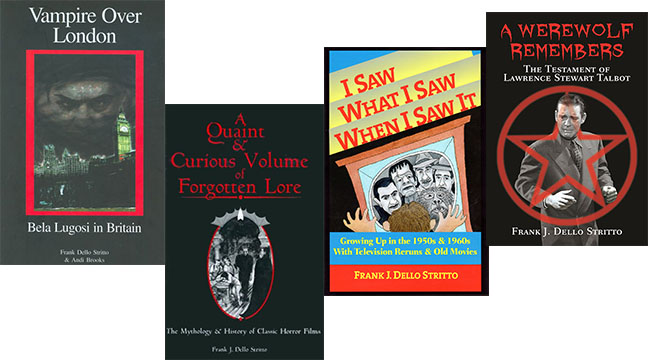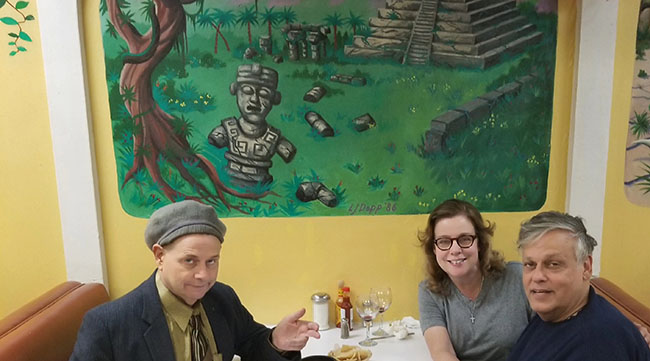|
|||||||||||||||||
November 2009 Web Edition Issue #3 |
|||||||||||||||||
| Mondo Cult Forum Blog News Mondo Girl Letters Photo Galleries Archives Back Issues Books Contact Us Features Film Index Interviews Legal Links Music Staff | Frank Dello StrittoA Conversationwith Michael CopnerWhen I was doing Cult Movies Magazine in the 1990s, I became close friends with our staff writer, Guy Tucker—a young man who saw things in films which were beyond the average viewer. A true boy genius, he taught himself to read, write and speak fluent Japanese by age 15. He traveled to Japan to meet and interview everyone at Toho Studios. I respected all about Guy, and was very sad when I heard that he had died in 2007. One time after six years of reading our magazine, Guy told me “the best thing you’ve got going in your pages is the work of Mr. Dello Stritto.” I concur that Frank was the greatest then, and he’s amazing in our Century 21. Frank still writes for monster magazines (currently he is a regular contributor to Monster Bash Magazine). His latest book, A Werewolf Remembers—The Testament of Lawrence Stewart Talbot, premiered in June 2017. In August 2017, I met with him and his wife Linda at the famed Los Burritos Mexican eatery on Hollywood Boulevard in Los Angeles. They were visiting from Houston, which was then experiencing record-breaking rains and floods. Frank and Linda were a bit worried about their home (which mercifully did not flood), but were otherwise the upbeat and entertaining people than I have now known for almost 20 years. Mike Copner: Your first articles Cult Movies Magazine were mainly reportage. Your researches uncovered new facts about old movies. Over time though, your writing became more analytical and interpretative. You looked within the movies themselves for themes and motives that had been overlooked. The same is true of your books. Your first one, Vampire Over London, dealt with a forgotten year in Lugosi’s life. Your most recent one, A Werewolf Remembers, is a novel. Yet you still write about the same movies. Your subject hasn’t changed but you have. Do you agree? Frank Dello Stritto: Oh, yes. I didn’t so much move on as move back. When I first saw the 1930s and 1940s horror movies, I didn’t wonder about Lugosi or Karloff or Chaney, etc. I wondered about the characters. Interest in the making and makers of the movies came later. I love researching the history of the movies, but my first love is delving into the movies themselves.  MC: When did you get the idea to try horror fiction, and do A Werewolf Remembers? FDS: Well, I had just finished my third book, I Saw What I Saw When I Saw It, which is a memoir about growing up with movies and television. My good friend, Bob Madison, called me, praised it to the skies, and then said, “I don’t think that you can ever do anything that good again.” Well, I wasn’t ready to hear that—I did not think that I had done the best that I could ever do. You know, unless you believe your next work will be your best, why do it? Then the idea jumped into my head: my first book (Vampire Over London) is history, my second (A Quaint & Curious Volume of Forgotten Lore) is analysis, and my third (I Saw What I Saw When I Saw It) is a memoir. So that left fiction. And then I decided that Lawrence Talbot should tell his own story. So, the novel is based on the discovery of his long-forgotten journals, which he left behind in La Mirada, Florida (the setting of Talbot’s last film appearance in Abbott & Costello Meet Frankenstein). MC: How much time to outline the story, and then get to a final draft? FDS: Once I decided that Lawrence Talbot would tell his own story, the plot unfolded pretty easily. The narrative had to be consistent with the plots of his five movies, and I had to fill in the gaps between their storylines. The actual writing started in August 2015, and a manuscript was ready to turn into a book in January 2017. Outlining the story did not take that long since I had been thinking about it my entire life. As a boy, I always wondered about the lives of the movie characters outside the movie. Lawrence Talbot is 31 at the opening of The Wolf Man, so I had to give him a youth. Then, I filled in the gaps between the movies. I was able to use those gaps to advantage. I had Talbot meet characters from other movies that never appear in his own. Filling in the time span between the end of House of Dracula (when Talbot is cured of lycanthropy) and the start Abbott & Costello Meet Frankenstein (when his curse reappears) became the core of the novel. MC: Twice through I have read A Werewolf Remembers, and plan to read it more. I think film directors should take and you and your werewolf to Universal Studios, make a plan to revive all their old monster franchise properties Have you talked to a show business agent about this—or any—of your books? FDS: The short answer is no. I think a television mini-series would be the best medium, but I will leave that to others. If anyone wants to talk to me about that, I’m listening, but I won’t be shopping the idea door-to-door. MC: What made you consider the two beasts meeting—fictional Lawrence Talbot and real-life Aleister Crowley? FDS: As I wrote the book, I was always looking for people—real-life and in the movies—whom Talbot never met in his movies and have them meet in the novel. So, he meets Dr. Yogami and Wilfred Glendon (from Werewolf of London), Andreas Obry (from Return of the Vampire) and a lot of others. When Talbot starts on his great quest to find Dracula (the prelude to Abbott & Costello Meet Frankenstein), he seeks out experts on the occult. Two of them were real-life figures: Montague Summers (who books on werewolves and vampires) and Aleister Crowley (perhaps Britain’s and maybe the world’s foremost occultist). Both were near the ends of their lives in the late 1940s, and so I had Talbot visit them in their homes. I hope that one of the pleasures of the book is that readers will never know who might turn up next in the story. So, throughout the book, Talbot meets everybody from Jack London to Carl Denham. They fit easily into the story.  L-R: Michael Copner, Linda and Frank Dello Stritto
MC: What’s your favorite film and why? FDS: I am glad you asked for “favorite,” and not “greatest,” since what is the greatest movie is an argument with no end. My favorite movie is Abbott & Costello Meet Frankenstein. I first saw it at the perfect age (11), and intentionally or not, it is the perfect transition from children’s entertainment to horror movies, from Abbott & Costello to Frankenstein. I can’t go into it here, but this unpretentious film has lots of depth and cleverness. It is one of those movies that the more I watch it, the more I see. Most people dismiss it as juvenile. That’s fine, but treasures await anyone who looks for them. MC: Well then, I have to ask, which film do you think is the greatest, and why? FDS: Well, I don’t have a good answer to that. I will confine myself to horror films. Island of Lost Souls is a great film, but so are King Kong and Bride of Frankenstein. I can’t compare them, and I cannot compare them to Rosemary’s Baby. Like I said, it is an argument that never ends. MC: D. W. Griffith felt film was the universal language spoken of in the bible which would teach people about all the other people on Earth. He felt making of film was his holy mission in life. How would you respond to that? FDS: I envy anyone who has a holy mission in life, and whose mission does not harm anyone. I can’t say that I have ever had that, but I have known plenty of people who have. Some have ruined themselves, some rose to great heights. I guess Griffith did both. MC: Lest we forget: I believe that you and I feel Bela Lugosi to have been the most intense, identifiable surrealistic actor on the silver screen. What are your latest thoughts on Bela? FDS: I have been a Lugosi fan since—guess when—I first saw Abbott & Costello Meet Frankenstein. Sure, he made a lot of films that I have trouble sitting through today. But when he was given half a chance, no one could touch him. Call it surreal, call it audacity, call it whatever. He had a magic that few could rival. As I get older, I feel a sadness in watching his grand movies. He could have appeared in so many more. If the fates had been kinder to him, if he could have managed his career better, we would have a lot more good Lugosi movies than the dozen or so that he left us. I am thankful for those, and grieve for the ones that might have been. Incidentally, Lugosi characters pop up often in A Werewolf Remembers. It is not just for Lon Chaney fans. | ||||||||||||||||




